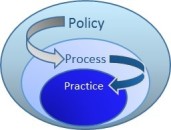Last week I wrote about the interesting interaction between these three dimensions as three different strategies for implementing change. This week I want to write one particular model of implementation, which I’ve called the ‘Practice makes perfect’ model.
As you may remember, the traditional method (in a Western context) looks like this:
 Let’s now think about some variations on this theme, and in particular what to do when you come across a business that doesn’t ‘think’ like yours does. By the way, my interest here is not the politically correct answer to the question…this is all about what really happens and how to make sure that we plan our intervention to have to the biggest impact possible.
Let’s now think about some variations on this theme, and in particular what to do when you come across a business that doesn’t ‘think’ like yours does. By the way, my interest here is not the politically correct answer to the question…this is all about what really happens and how to make sure that we plan our intervention to have to the biggest impact possible.
The ‘Practice makes perfect’ model
You see this in organisations which have been set up and run by owners with deep technical expertise, where the key influencers still sit on the factory floor or in the R&D function. In this company, the pace of change is rapid and innovation comes from everywhere and is not at all constrained. Some other features might be:
- Companies which operate like this are flat in structure with very little hierarchy. Ownership may be widely held.
- The line to policy is tenuous…where there is policy, it’s limited and more about things that will get you fired because of the conflict with the core values of the owners / founders.
- Equally process is incredibly strong in certain areas which correspond with the core skills / reputation of the business and either non-existent or weak in other areas.
- Customers are recognised as being at the heart of the business and often co-innovate with the company…they buy into this position of influence and have both a personal and a corporate connection with the company and its owners.
- The functions which own process (finance, HR, IT) are underweight in terms of investment, quality of people, technology and most importantly influence. This is probably the best indicator ever that process does not necessarily work well as a lever of change.
Creating change here…things that won’t work!
- Working through policy as the method of change is a waste of time in this context. No employee in this type of organisation has ever thought to read / let alone take seriously a policy as part of their day to day activities…and trying to create that sort of behaviour is likely to cause a riot! And significant loss of productivity / creativity which is probably the reason why you bought it in the first place.
- Process based change has more impact but it’s likely to be retrospective rather than proactive ie. We, the target group of employees, will review what we normally do in the light of the new process and amend at the edges to retro-fit. We will also question actively what value the new process adds to our business and if it’s not clear, challenge loudly. We may have some sympathy with the concept of risk and reputation but at the margins rather than at the core of our work. Our personal sense of value does not resonate with process based change but with innovation at the sharp end of the business!
Creating change here…things that work!
- You are at the mercy of the owners or those that they trust the most here. Removing leadership can work but only if you observe that there is a layer of competence which has been restrained or has the capability to move up. This has to be a change process based on influencing rather than enforcing.
- The argument / context for change needs to be articulated well not just around business opportunity but also around the potential benefit for the employee base.
- Pick one or two areas which have a strong emotional case and deal with a core issue…use these to create some movement. Be extremely clear about the case and the rationale….you cannot afford to fail otherwise your credibility will be shot.
I suspect that in certain ownership structures (family owned for example), this is the most prevalent model. It pays to understand it and work from within it.
- More evidence of the link between culture and M&A success
- The big myth in post acquisition integration
Categories: Change management, Complex transformation, Disruptive Innovation, Mergers & acquisitions, Organisational Structure, Post merger integration, psychology, Transformation
Tags: change management, Collective behaviour, Complexity, creativity, culture, Decision making, Employee engagement, innovation, Merger integration, productivity, stakeholder management


Hi Ben,
I understand the Practice concept and interestingly working on a family owned merger at the moment.
I think there’s philosophical point here on the notion of implementing change, and that is dealing with immediate solutions to practical problems and then abstracting these solutions to processes and policies that could address such problems re-occuring in future.
I would agree that while it’s tempting and natural for consultants to come in with policies and processes to address change. The practical person is simply looking for answers to immediate problems. So dealing with the here and now and then making the link to process and policies is one that’s more likely to work.
The subtlety of culture change is a good case in point.Even talking about culture change conceptually wins no friends. But dealing and creating practical solutions to behavioural issues (eg decision making, poor time management, communication etc) is going to create far more progress than running a ‘culture change’ project.
Toby
LikeLike
Good to hear from you Toby. I think you make some powerful points around practical implementation….an agile form of implementation if you like. There is much confusion around culture change…for one Australian company I worked for recently, this was purely about doing some kind of engagement survey…and nothing I could say would persuade them otherwise!!
LikeLike
Ben – super, super interesting – I’m working in an organization where the leadership is elected for fixed 3 to 5 year terms, whereas the staff have been in post for an average of 25 years or so. Policy has negligible impact on practice. Process is in people’s heads. The case for change is great (driven externally) but institutional inertia almost insuperable. Would be interested in any ideas or clues you have for creating change in such organisations at great speed. I’m not sure there’s time to pick one or two areas….
LikeLike
Let me have a think and give you a call…good to hear from you, Nick
LikeLike
You are pretty much right on.
I would also add that we tend to forget to apply creativity in how we sell our ideas. Obviously it makes sense to start small and work up to bigger, bolder ideas – especially when approaching the executive team. This will give an idea of what you can expect, setting up a frame for how to pitch/deliver the idea.
LikeLike
Thanks for your comment, Jeffrey…glad you liked it. The pilot is always good, I complete agree….gives some momentum and a degree of internal leverage. Also allows you to choose your initial victims carefully 😉
LikeLike